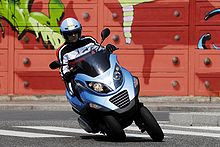Piaggio
| Piaggio & CSpA
|
|
|---|---|
| legal form | Società per azioni |
| ISIN | IT0003073266 |
| founding | 1884 |
| Seat |
Pontedera , Italy |
| management | |
| Number of employees | 6,515 |
| sales | 1.39 billion euros |
| Branch | vehicle construction |
| Website | www.piaggiogroup.com |
| As of December 31, 2018 | |
Piaggio is an Italian vehicle manufacturer based in Pontedera . The company produces various mopeds and scooters , including the Vespa , the Ape cargo tricycle and the Porter van .
The group also includes the motorcycle brands Aprilia , Derbi , Gilera , Laverda and Moto Guzzi .
Piaggio has worked in various industries throughout its history. From wood storage to shipbuilding, railway construction, aircraft and automobile construction it went to the motor scooters. In 2014, a profit of 69.7 million euros was achieved on sales of 1.2 billion euros. In 2014 about 7,500 employees produced 550,000 vehicles. On January 1, 2016, 332,605 Piaggio motorcycles were registered in Germany, which corresponds to a share of 7.9 percent.
history
The Piaggio company was founded in 1884 by Rinaldo Piaggio . His father, Cavalier Enrico Piaggio, laid the foundation stone by buying a piece of land in Sestri Ponente , Genoa , originally for a timber warehouse, in 1882 . Initially, the family company Piaggio concentrated on shipbuilding. Later they switched to the construction of railroad cars. With the advent of aviation , Rinaldo Piaggio turned to aircraft construction . He found the right engineers and began building aircraft in 1916; for this purpose he built a new plant in Pontedera .

Due to the war, Piaggio was very successful in the late 1930s, as the Italian army was one of the company's customer base. During the Second World War, however, the main factory in Pontedera was completely destroyed. After 1945 the victorious powers decided that Piaggio was no longer allowed to manufacture armaments. Rinaldo's son, Enrico Piaggio, has now taken over the management of the company. He observed that there was an increased need for inexpensive means of transport in Italy, as mobility had stalled due to the destruction and reconstruction of Italy. To counter this fact, Piaggio developed a scooter , which he sold in 1946 under the name Vespa [ital. "Wasp"].
In the following years Enrico Piaggio continuously expanded the model range. In 1948 the company presented a three-wheeled van, the Ape [ital. "Bee"]. In 1957 she presented the small car Vespa 400 at the Paris Motor Show . Four-wheeled vans were added later. The Ciao model followed in 1967 , a new generation of moped models that was particularly popular with young people.
In 1987 the company took over the Austrian moped manufacturer Puch . In the 1990s, Piaggio launched various scooters that did not go under the Vespa label : Piaggio Hexagon , Piaggio Sfera , Piaggio Skipper , Piaggio Zip . In 1999 Deutsche Bank took over 80% of the shares in Piaggio through its subsidiary Morgan Grenfell Private Equity for 1.35 trillion Lire. In 2003 the shareholder structure changed again: the Italian billionaire Roberto Colaninno took over 31.25% through his holding company Immsi , a consortium of 27 creditor banks 37.5% and 31.25% remained with Morgan Grenfell . Today Immsi Spa holds around 55% of the share capital in Piaggio.
After Piaggio took over the Spanish two-wheeler manufacturer Derbi in 2001, the well-known Italian motorcycle companies Aprilia (including the Laverda brand ) and Moto Guzzi followed in 2004 . Piaggio is now the market leader in scooter construction in Europe. Piaggio has been listed on the stock exchange since 2006. [obsolete] In June 2014, Piaggio Deutschland GmbH moved from Kerpen to Düsseldorf.
With the scooter MP3 , a completely new vehicle concept with three wheels was presented in 2006.
Models
Piaggio currently sells Vespa and Piaggio motorcycles as well as the Aprilia, Derbi, Gilera, Laverda and Moto Guzzi models listed in the relevant articles . The models of the Vespa brand have a self-supporting sheet metal body ( PX , LX , GTS ), those of the Piaggio brand ( e.g. Piaggio Zip , NRG, TPH ) have a tubular steel frame and a plastic body. The engine range extends from 50 to 500 cm³.
Scooter mobiles

The Ape has been built since 1947 and has between 50 and 422 cm³ displacement. An electric drive is also installed.
- Ape A
- Ape B
- Ape C
- Ape MP
- Ape 50
- Ape Car
- Ape TM
- Ape Car Max
- Ape porter
- Ape 50 Cross Country
- Ape 50 TL5T
- Ape 50 ZAPC
- Ape Classic
- Ape Classic 400
- Ape Calessino
Vespa brand models

- Vespa 50 (1963 to the 1990s)
- Vespa 150 Sprint (1965–1976)
- Vespa 125 Primavera (1967–1982)
-
Vespa PX (~ 80, ~ 125, ~ 150 and ~ 200 cm³, 1977–2008)
- Vespa T5 (125 cc two-stroke engine with five overcurrent channels)
- Vespa PK (~ 50, ~ 80, ~ 100 and ~ 125 cm³, 1983–1996)
- Vespa Cosa (125 and 200 cm³ two-stroke engine, four-speed manual transmission 1988–1998)
- Vespa ET 2 50 (1996-2005)
- Vespa ET2 Inizione (50 cm³ two-stroke engine with separate oil injection, variator 1997–1998)
- Vespa ET 4 50 (50 cm³ four-stroke engine 2002-2005)
- Vespa ET4 125 (125 cc four-stroke engine 1996-2005 since 2000 LEADER engine)
- Vespa LX 50 (2- or 4-stroke engine, since 2005)
- Vespa Primavera (air-cooled 50 cm³ two-stroke engine, 50 cm³, 125 cm³ and 150 cm³ four-stroke engine, variator, since 2013)
- Vespa GT (2003-2007)
- Vespa GTS (~ 125 and ~ 300 cm³, water-cooled 4-valve-4-stroke engine, injection, variator, since 2006)
- Vespa LX (~ 125 and ~ 150 cm³, air-cooled 3-valve four-stroke engine, injection, variator, since 2005)
- Vespa Sprint (air-cooled 50 cm³ two-stroke engine, 50 cm³, 125 cm³ and 150 cm³ four-stroke engine, variator)
- Vespa PX (~ 125 and 150 cm³, new edition of the old PX , air-cooled 1-cylinder 2-stroke engine, 4-speed gearbox, manual, since 2011).
- Vespa 946 (air-cooled 125 cm³ and 150 cm³ four-stroke engine with 3 valves, variator, ABS and ASR, since 2013)
Mopeds

All models have a two-stroke engine with 50 cm³ displacement
- Ciao (1968-2006)
- Boxer (1970–1972) → Boxer 2 (1972–1978) → Si (1978–2001)
- Bravo (1973-2001)
- Boss (1988–1989) → Grillo (1989–1996)
Scooter
Up to 50 cm³
- Fly (air-cooled 2-valve four-stroke engine)
- Free (2-stroke engine)
- Liberty (2- and 4-stroke engine)
- Quartz (water-cooled 2-stroke engine, chassis like large scooter SKR)
- Sfera
- TPH 50 2T (2-stroke engine)
- Zip (2- and 4-stroke engine, since 1990s)
- NRG (2-stroke engine, since 1994)
- Diesis (2-stroke engine, 2001-2005)
More than 50 cm³
- Fly (~ 125 cm³, air-cooled 3-valve four-stroke engine, injection, variator)
- Carnaby (~ 125, ~ 200, ~ 250 and ~ 300 cm³, 2007–?)
- Beverly (~ 125, ~ 200, ~ 250, ~ 300, ~ 350, ~ 400 and ~ 500 cm³, since 2001)
- Liberty (~ 125 cm³, air-cooled 3-valve four-stroke engine, injection, variator)
- Sfera (~ 80 and ~ 125 cm³)
- TPH later "Typhoon" (~ 80 and ~ 125 cm³, 4-stroke engine)
Large scooter

- Skipper and SKR (~ 125 and ~ 150 cm³, 1993-2004)
- Hexagon (~ 125, ~ 150, ~ 180 and ~ 250 cm³, 1994–2003)
- X9 (~ 125, ~ 200, ~ 250 and ~ 500 cm³, 2000–2009)
- X8 (~ 125, ~ 200, ~ 250 and ~ 400 cm³, 2006–?)
- X7 (~ 125, ~ 250, ~ 300 and ~ 400 cm³, 2008–2012)
- X10 (~ 125, ~ 350 and ~ 500 cm³, since 2012)
- MP3 (three-wheeled scooter, ~ 300 and ~ 500 cm³ in various equipment variants, since 2006)
Engines
- Hi-PER 2 (two-stroke engine)
- Hi-PER 4 (four-stroke engine)
- Purejet Engine (with injection)
- MASTER (280 cm³, 399 cm³, 460 cm³ and 493 cm³, water-cooled, since 1998)
-
LEADER (air and water cooled, 1999–2010)
- 124 cm³, 151 cm³ and 198 cm³, air-cooled four-stroke engine with 2 (SOHC) valves, 2000-2010
- 124 cm³, 182 cm³, 189 cm³ and 244 cm³, water-cooled four-stroke engine with 4 (SOHC) valves, 2000-2010
- Quasar (124 cm³, 244 cm³ and 278 cm³, water-cooled four-stroke engine with 4 valves, since 2003)
- LEM (124 and 155 cm³, air-cooled four-stroke engine with 3 valves, since 2012)
Piaggio Museum
The Piaggio Museum was inaugurated in March 2000 in the tools department of the old factory, one of the oldest buildings in the Pontedera factory complex. The company relocated its production to this historical area in the early 1920s. In April 2018 the Piaggio Museum was expanded. The museum now has an area of 5000 m² and more than 250 exhibits. It is the largest and most comprehensive Italian museum dedicated to two-wheelers. In addition to the exhibition space dedicated to the permanent collections, the Piaggio Museum also has 340 m² of temporary exhibition space, which allows the museum to vary its cultural offerings, from art to technology to scientific unveiling and fashion. Over the years, exhibitions, events and works by various artists of modern and contemporary art have taken place here. In 2003, the Piaggio Museum and the Historical Archives were recognized as the best museum and best commercial archive in Italy during the 2003 Economy and Culture Prize.
Piaggio Aero Industries
Web links
- Piaggio Group website (Italian, English)
- Piaggio Germany
- Piaggio Austria
- Piaggio Switzerland
Individual evidence
- ↑ piaggiogroup.com - Management
- ↑ a b piaggiogroup.com - Financial Statements 2018 , accessed April 8, 2019
- ↑ Vehicle registrations (FZ) - Stock of passenger cars and motorcycles by brand or manufacturer January 1, 2016. (PDF) In: kba.de. Federal Motor Transport Authority, January 1, 2016, p. 9 , accessed on January 14, 2017 .
- ↑ Vespa manufacturer moves to Düsseldorf. Archived from the original on April 29, 2014 ; accessed on March 9, 2018 .
- ↑ a b c The Piaggio Museum was expanded - wasp sheet archive . In: Waspenblech Archive . ( square7.ch [accessed on July 18, 2018]).






